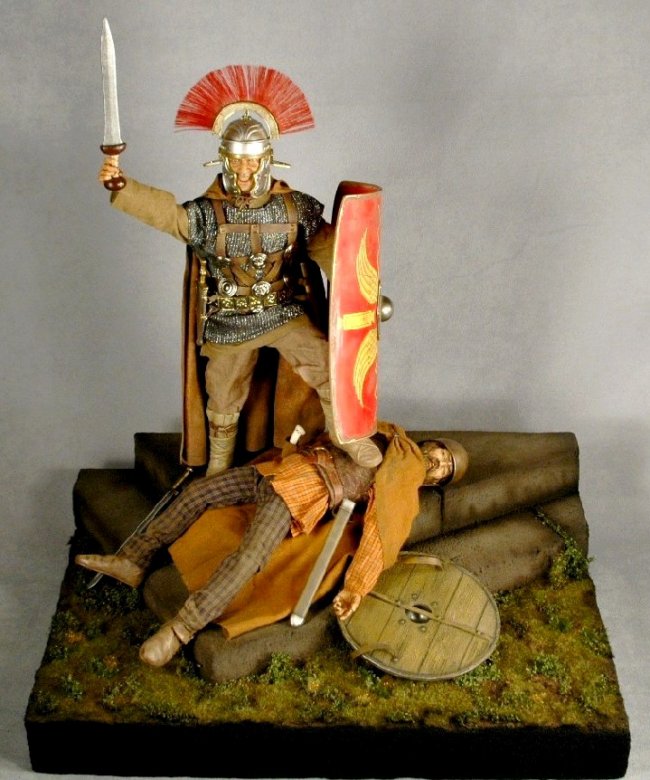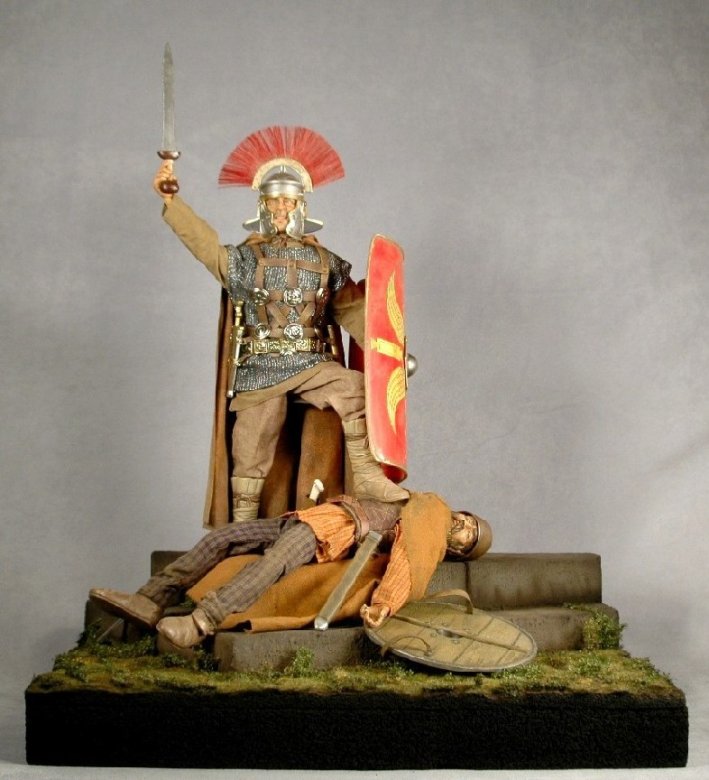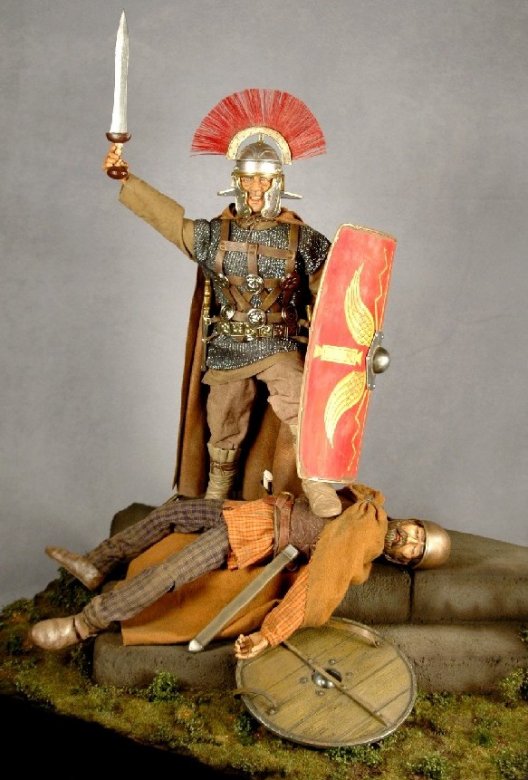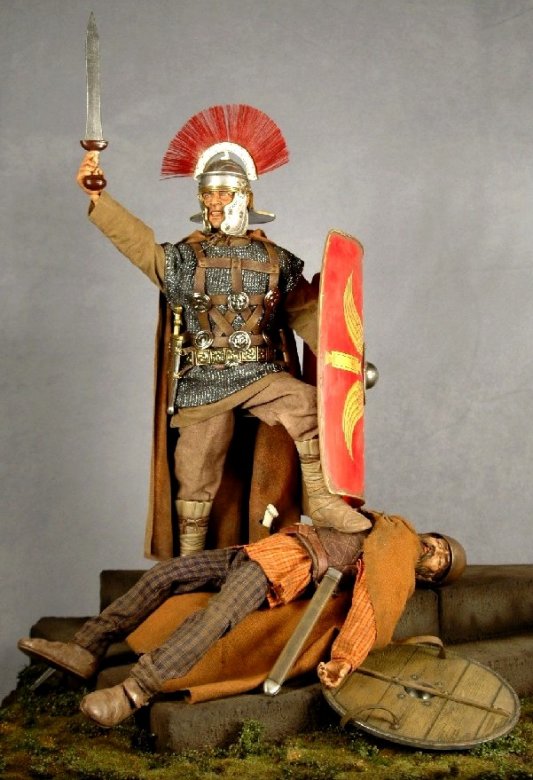“Adsum Viginti !”Legio XX Valeria Victrix Centurion and Caledonian tribal leader
Battle of Mons Graupius
North-east Scotland, 84AD











In AD 79 General Gnaeus Julius Agricola, Roman Governor of the Province of Pretania (Britain ), sent a fleet to survey and map Scotland’s coast. By AD 83 Agricola had advanced conquering southern Scotland and the Caledonian tribes to the north knew that they faced imminent invasion.
It was at this point that the Roman historian Tacitus records that the Caledonians "turned to armed resistance on a large scale". Obviously recognizing the might of the highly disciplined Roman war machine, the Caledonians employed guerrilla tactics attacking individual Roman forts and small troop movements. In one surprise night-attack, the Caledonians nearly wiped out the whole 9th legion. It was only saved when Agricola’s cavalry rode to the rescue.
By the summer of AD 84 Agricola and his legions had pushed deep into the Caledonian homelands in the north-east of Scotland. It was on this march, at a place the Romans recorded as Mons Graupius (somewhere in the Grampian Mountains, perhaps at Bennachie by Inverurie), that the Caledonians made the fatal error of confronting them head on.
It is said that some 30,000 Caledonians faced a Roman army of about half that size. It is also recorded that the Caledonians had the advantage of the higher ground, but just like Boudicca some 40 years earlier, they lacked the organisation, discipline and military tactics of the Roman legions.
The tightly packed Roman ranks relied upon their short stabbing sword in combat. Their front ranks were made up of auxiliary troops conscripted from Germany, Holland and Belgium, with the seasoned veterans of Roman legionaries holding things together towards the rear. Bloody hand to hand fighting followed and at one point the Caledonians, with their numerical supremacy managed to outflank the Romans, but once again the highly mobile Roman cavalry rode into action to save the day for them.
With that cavalry charge it appears that any hopes of a Caledonian victory vanished and in the bloodbath that followed 10,000 men were slaughtered. As well as those who fought valiantly to the bitter end, many fled into the surrounding forests and mountains burning their houses and killing their own wives and children in fear of Roman reprisals.
On the following day Tacitus records, "...the hills were deserted, houses smoking in the distance, and our scouts did not meet a soul."
Following their defeat at the Battle of Mons Graupius, the Caledonian tribes must have considered that their days were numbered, but then luck intervened. The Emperor Domition ordered Agricola back to Rome to help resolve the more pressing military crisis on the Rhine and Danube frontiers.
For the next 100 years there were two more invasions one in 209AD led by Emperor Severus taking personal control of leading the invasion of 40,000 Roman troops into Caledonia.
After all the efforts, all the expense, all the building and all the years of war - Caledonia would still be defiant, unconquered and free.
The based vignette shows a Centurion from Legion XX Valeria Victrix as he celebrates over the dead body of a Caledonian tribal leader in the battle of Mons Grapius.
Always wanted to do something like this. One ofm y favorite miniatures was a two figure vignette in 77mm by a company called “Series 77” in the 70s which showed a Ronam legionary over a defeated Germanic warrior. So I tried to do something similar on this piece which was my entry in a based figure contest in the AUS forum in Spain.
“Adsum Viginti” is meant to mean “20th Present” or “20th is here” etc making reference to the 20th Legion.
Base is made from pieces of styrofoam, covered with carpenter’s glue and painted with the airgun. Various layers of glue and sand, then static grass and other scenic materials on the grassy areas.
Centurion’s HS is DML Bobby Dalton. Tunic, trousers and footwear from DML Ermanarich. Chain mail piece from Ignite parts box. The rest is all from the Ignite Centurion figure except the cape which came with another Ignite Roman figure.
The dead chieftain’s HS is DML Ermanarich with repainted eyes to have them appear closed.. His tunic is shortened from an Outremer Ignite knight, Trousers,footwear, shield and knife are from Ignite Viking. The sword, scabbard and cape from Ermanarich figure. Belt is Rio Rondo leather and Ignite Roman buckle. Helmet is from Ignite Republican legionary with chin pieces removed and replaced with a Rio Rondo leather strap. Quilted vest is from Ignite Roman Centurion figure, with leather straps removed and dyed from the original white color.
Everything weathered and retouched with acrylic washes and dry-brushing.





